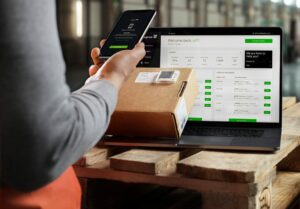Thanks to the advancements brought about by technology to manufacturing and logistics, any enterprise can easily go global today.
Even small businesses serving local customers and niche markets can now leverage supply chains worldwide. Yet, exciting as these may all seem, supply chains aren’t perfect. Inefficiency at any point in the supply chain can have a ripple effect and impact all stakeholders. Mishandling, incorrect orders, defective items, and product damage all contribute to waste.
Dealing with any of these factors entails costs. Small businesses, even with their limited resources, have to absorb part of the costs of waste. As such, effectively managing their supply chains is critical to their success. So, regardless of their spot in the chain, they must work on efficiency together with their partners.
We recently got in touch with Janne Juhala, CEO of shipment monitoring start-up Logmore, and asked him about small businesses, their role in supply chains, and how his company is empowering supply chain stakeholders to become more efficient.
There have been plenty of positive developments in logistics and global supply chains over recent years. How have these trends impacted small businesses in particular?
On the one hand, being a small business has become a lot easier in many ways. New tech like developments in ecommerce make it easy for pretty much anyone to start a business. Fancy systems that used to be almost exclusive to enterprises like webshop platforms, ERP systems, and integrated shipping and monitoring services are now available even to the smallest micro business.
On the other hand, small businesses still have to navigate the markets dominated by large corporations. This forces these smaller enterprises to play to their strengths and leverage their flexibility. Corporations can’t make decisions as fast as small businesses, which means they have less capability to adjust based on the circumstances. Networks of small businesses can even achieve amazing results through close cooperation. A small business could use trusted local carriers and source their materials from local suppliers.
But despite these developments, inefficiency and waste continue to be troublesome issues for supply chains. How do these issues directly affect small businesses?
I think small businesses are actually in a better position to minimise inefficiency, since they really can’t afford waste anyway. The flexibility I mentioned plays a big part in this. Once a small business discovers an issue, they tend to be quicker at fixing it. Small companies can use their data very efficiently. If the CEO themselves see that ten per cent of their inventory is wasted regularly, they can make the change to decrease the future inventory of that product. Similarly, partners not holding up to expectations can be swiftly replaced in many cases.
That said, they can also contribute to waste. Micro companies sometimes have an aversion to tech. Education helps, but many sound investments can look like just extra expenses that can be skipped. Some old-fashioned entrepreneurs might think they can just as easily mark down temperatures manually, or manually track their inventory through a notebook. Both methods are very inefficient and should be easily automated. You’d think people would go paperless and digital since they have the opportunity to do so.
How can these issues be solved? What role can small businesses play in improving supply chains?
Last-mile delivery is one of the areas where small businesses can have a huge impact. A lot of it is handled by small local carriers. Just choosing efficient, reliable carriers is a way to drive the last-mile scene toward a specific direction.
Innovations are also very much a small company thing. So, many companies start off from a single new idea, like Logmore. Sharing and developing new ideas that solve a profound challenge the company is facing is a way to bring new, better solutions to the world. Every company has its own set of challenges and coming up with new ways to solve them or repurposing an existing solution is a big deal.
Your solution, Logmore, is a shipping data-logging and monitoring service. How does this solution help solve supply chain issues?
Logmore combines our own data loggers and the cloud to create a one-size-fits-all solution for keeping track of temperature variance, humidity levels, shocks and even ambient light that packages go through. With that data, companies can evaluate both their own processes and those of their carrier networks.
For instance, when a small food company sends a package of fridge-temperature products, they want to be sure that the goods stay that temperature. Place a Logmore QR Tag into the thermal container along with the products, and the tag tracks the temperature throughout the shipping. If there’s an issue somewhere along the way, the sender, recipient and even the carrier will know when the issue occurred and who’s responsible. Finding out about these issues in time helps prevent the loss of goods.

The logistics industry grows fast, and for us and our customers to grow with it, scalability is a central thing. The system needs to be lightweight. Our patented dynamic QR codes combine data storage and data transmission. It’s much faster than any alternative on the market, since you just need to scan the QR code on the tag using a smartphone to upload the collected data to our cloud service. Shippers can immediately see their packages’ condition through our web dashboard.
Can small businesses use your solution? What benefits can they enjoy using your solution?
Logmore’s scalability makes it accessible for any business size. Before our service became available, an even somewhat comparable monitoring setup was so cumbersome and multipart that only large companies could implement it in an efficient way. We streamlined the processes so that even the smallest company can benefit from it.
So, the scalability goes both ways. Anyone can benefit from Logmore, regardless of whether they have one or a million things that they want to monitor. A business could have only ten Logmore QR Tags that they can use over and over again for internal processes, or a subscription for regular batches of hundreds or even thousands of QR Tags to be sent out with their outgoing shipments.
For instance, the Association of Finnish Pharmacies recommended us to its member pharmacies for online pharmacy shipments. The smallest of the pharmacies have only one or two Logmore QR Tags that they use and reuse. Their process is rather simple by principle: they receive an order, ship it with a QR Tag in the package, and the local customer returns the QR Tag in a return envelope once they’ve received the shipment.
We’re experiencing a global pandemic where supply chains are being disrupted. What kinds of challenges should small businesses expect in light of the situation?
It’s definitely tougher for small businesses. Large corporations can adjust their internal operations to compensate for changes in their supply chains. Small businesses may have altogether larger issues if a partner suddenly can’t deliver or can’t match their updated needs.
Fluctuating demand can create problems for carriers as well. When demand spikes, a small carrier company could find itself in a situation where there’s more goods that need to be moved compared to their capacity to deliver. Overbooked carriers might struggle to meet deadlines which, in turn, leads to delayed deliveries.
Not getting the materials in time for production can cause delays as well. This has been made clear this year; we had some challenges with logistics as well due to production not having all the components on time. Fortunately, the situation looks to be improving, but this was definitely a learning experience for us.
How do you think business should adapt moving forward? What role do you foresee your company playing in such a landscape?
Companies should focus on becoming or staying data driven. There’s always the external pressure from legislative and regulatory authorities, but they should have the internal drive to collect and use data. Insights from data allow companies to improve and develop their competitive advantage rather than just meet the minimum requirements. Since small companies can develop rapidly to match whatever changes the future brings, they should capitalise on it.
Customer expectations can change suddenly, like we saw earlier this year. Small businesses have shown they can react quite quickly to these changes. They were able to set up ecommerce solutions on short notice to compensate for decreased physical store visitors. They were also able to change inventory size to match the changed demand.
From Logmore’s perspective, we’re pushing down the price of data logging while keeping our monitoring versatile. This way we can better serve both small and large customers. I believe smaller businesses are certain to come up with new use cases that we haven’t thought about ourselves! We’re already working on making the service so affordable that any company could have a Logmore logger on every cardboard box they send out. We might even empower whole new businesses that wouldn’t have been previously profitable to succeed in today’s landscape.





